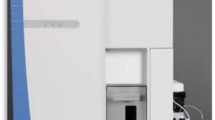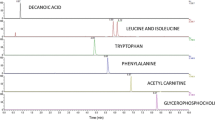Abstract
Inductively coupled plasma-mass spectrometry (ICP-MS) is a powerful tool for both quantitative multielement analyses of inorganic elements and measurement of isotope ratios (IRs). The main disadvantage of this technique is the existence of polyatomic isobaric interferences at some key masses. Zinc has been investigated for such potential interferences in serum or plasma. The Zn isotopes,66Zn and68Zn, have no apparent interferences, but32S16O2 and32S2 are isobaric with64Zn. The possible effects of S and other major components of blood plasma—Na, K, Cl, P, Ca—on Zn IRs were investigated using a series of mineral solutions which simulated human plasma with respect to these elements. The mixture of all mineral elements interfered only with64Zn (6.66 ng/mL) and70Zn (8.51 ng/mL). Interferences to66Zn,67Zn, and68Zn were minimal containing 0.90, 0.94, and 0.39 ng/mL, respectively. The copresence of Na or S shifted35Cl16O2 (atomic mass 67 coming from Cl solution) to35Cl2 which reduced the contribution to67Zn. The hypothesis that Zn IRs obtained from plasma at various intervals after the intravenous administration of enriched67Zn to humans would reflect those obtained after extraction of Zn was therefore tested. To compare the two pretreatment methods, “extraction” versus “nonextraction,” specimens were collected from 10 human subjects at intervals of 5 min to 24 h postinjection, and in 4 subjects from 5 min to 9 d postinjection. Two separate aliquots of plasma from each time-point were dried and digested with hydrogen peroxide, and the residue dissolved in nitric acid. One specimen was subjected to zinc extraction using ammonium diethyldithiocarbamate chelate followed by back extraction into nitric acid. The matching aliquot received no further pretreatment. The normalized IRs obtained from67Zn/66Zn and67Zn/68Zn in both the “extracted” and “nonextracted” samples agreed well(r 2 = 0.976 andr 2 = 0.985, respectively) compared to those from other ratios (r 2 = 0.838 for67Zn/64Zn andr 2 = 0.747 for67Zn/70Zn). Considering the minimum possibility of isobaric interferences in plasma samples,67Zn/68Zn obtained from “nonextracted” samples is sufficient for routine Zn kinetic analysis by ICP-MS.
Similar content being viewed by others
References
R. L. Goldenberg, T. Tamura, Y. Neggers, R. L. Copper, K. E. Johnston, M. B. DuBard, et al.,JAMA 274, 463–468 (1995).
D. M. Foster, R. L. Aamondt, R. I. Henkin, and M. Berman,Am. J. Physiol. 273(5), R340-R349 (1979).
R. I. Henkin, D. M. Foster, R. L. Aamondt, and M. Berman,Metabolism 33, 491–501 (1984).
M. E. Wastney, R. L. Aamondt, W. F. Rumble, and R. I. Henkin,Am. J. Physiol. 251, R398-R408 (1986).
R. A. Dunn and R. J. Cousins,Am. J. Physiol. 256, E420-E430 (1989).
N. M. Lowe, I. Bremmer, and M. J. Jackson,J. Nutr. 65, 445–455 (1991).
T. Hawkins, J. M. Marks, V. M. Hummer, and M. W. Greaves,Clin. Exp. Dermatol. 1, 243–252 (1976).
J. R. Turnlund, M. C. Michel, W. R. Keyes, J. C. King, and M. C. Margen,Am. J. Clin. Nutr. 35, 1033–1044 (1982).
J. R. Turnlund, J. C. King, W. R. Keyes, B. Gong, and M. C. Michel,Am. J. Clin. Nutr. 40, 1071–1077 (1984).
J. R. Turnlund, N. Durkin, F. Costa, and S. Margen,J. Nutr. 116, 1239–1247 (1986).
N. W. Istfan, M. Janghorbani, and V. R. Young,Am. J. Clin. Nutr. 38, 187–194 (1983).
L. V. Miller, K. M. Hambidge, V. L. Naake, Z. Hong, J. L. Westcott, and P. V. Fennessey,J. Nutr. 124, 268–276 (1994).
M. J. Jackson, D. A. Jones, R. H. T. Edwards, I. G. S. Swainbank, and M. Coleman,Br. J. Nutr. 51, 199–208 (1984).
M. J. Jackson, R. Giugliano, and L. G. Giugliano,Br. J. Nutr. 59, 193–203 (1988).
M. Janghorbani, T. G. Bill, and V. R. Young,Clin. Chim. Acta 108, 9–24 (1980).
I. G. Gokmen, N. K. Aras, and G. E. Gordon,Anal. Chem. 61, 2757–2763 (1989).
M. E. Wastney, I. G. Gokmen, R. L. Aamodt, W. F. Rumble, G. E. Gordon, and R. I. Henkin,Am. J. Physiol. 260 (Regulatory Integrative Comp. Physiol.29), R134-R141 (1991).
S. Fairweather-Tait, M. J. Jackson, T. E. Fox, S. G. Warf, J. Eagles, and P. C. Croghan,Br. J. Nutr. 70, 221–234 (1993).
P. L. Peirce, K. M. Hambidge, C. H. Goss, L. V. Miller, and P. V. Fennessey,Anal. Chem. 59, 2034–2037 (1987).
J. K. Friel, V. L. Naake, Jr., L. V. Miller, P. V. Fennessey, and K. M. Hambidge,Am. J. Clin. Nutr. 55, 473–477 (1992).
L. Sian, X. Mingyan, L. V. Miller, L. Tong, N. F. Krebs, and K. M. Hambidge,Am. J. Clin. Nutr. 63, 348–353 (1996).
R. E. Serfass, J. J. Thompson, and R. S. Houlk,Anal. Chim. Acta 188, 73–84 (1986).
N. M. Lowe, A. Green, J. M. Rhodes, M. Lombard, R. Jalan, and M. J. Jackson,Clin. Sci. 84, 113–117 (1993).
J. K. Friel, H. P. Longerich, and S. E. Jackson,Biol. Trace Element Res. 37, 123–136 (1993).
K. Yokoi, N. W. Alcock, and H. H. Sandstead,J. Lab. Clin. Med. 124, 852–861 (1994).
K. Yokoi, N. W. Alcock, and H. H. Sandstead,Biochem. Res. Trace Elements 5, 69–76 (1994).
H. Vanhoe, C. Vandecasteele, J. Versieck, and R. Dams,Anal. Chem. 61, 1851–1858 (1989).
K. Yokoi, V. M. Sadagopa Ramanujam, N. G. Egger, H. H. Dayal, N. W. Alcock, and H. H. Sandstead,FASEB J. 11, A407 (1997).
V. M. Sadagopa Ramanujam, K. Yokoi, N. G. Egger, H. H. Dayal, N. W. Alcock, and H. H. Sandstead,FASEB J. 11, A407 (1997).
N. G. Egger, K. Yokoi, V. M. Sadagopa Ramanujam, H. H. Dayal, N. W. Alcock, and H. H. Sandstead,FASEB J. 11, A407 (1997).
N. W. Alcock,Biol. Trace Element Res. 13, 363–370 (1987).
Author information
Authors and Affiliations
Rights and permissions
About this article
Cite this article
Ramanujam, V.M.S., Yokoi, K., Egger, N.G. et al. Polyatomics in zinc isotope ratio analysis of plasma samples by inductively coupled plasma-mass spectrometry and applicability of nonextracted samples for zinc kinetics. Biol Trace Elem Res 68, 143–158 (1999). https://doi.org/10.1007/BF02784403
Received:
Revised:
Accepted:
Issue Date:
DOI: https://doi.org/10.1007/BF02784403




